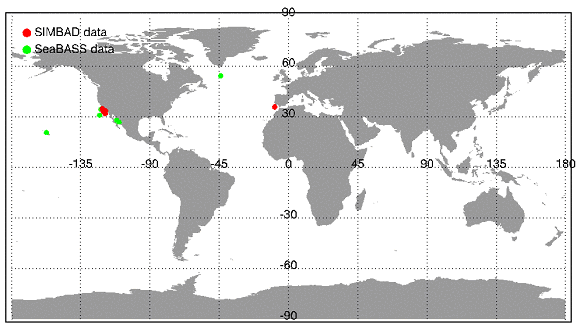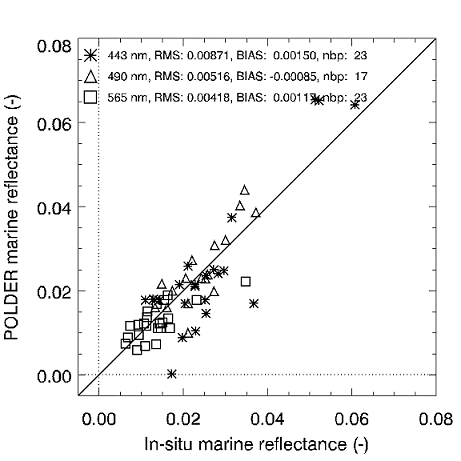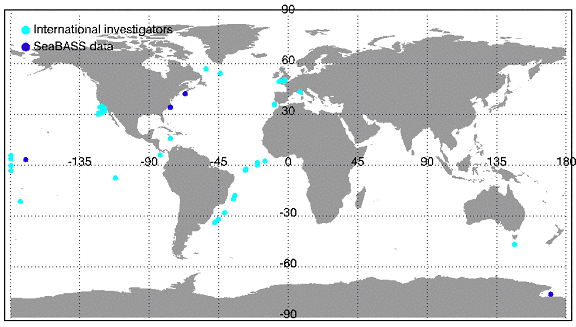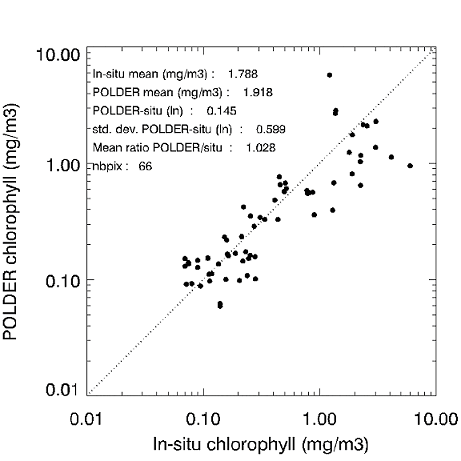VALIDATION PROCESS

POLDER 1 Validation Process and Results |
As the validation process has not been applied to the final POLDER 1 products, we present here the results obtained for the first version of POLDER 1 products.
A specific effort had been made to validate POLDER 1 retrieved marine reflectance and chlorophyll-a concentration:
- for marine reflectance validation, SIMBAD radiometer measurements (discarding the measurements used for POLDER vicarious calibration) and SeaBASS (SeaWiFS Bio-Optical and Storage System) data have been used. SIMBAD data are also available in SeaBASS.
- for chlorophyll-a validation, data from many international investigators have been gathered by POLDER Principal Investigators (PIs) and used for validation purposes. SeaBASS data have also been used and added to POLDER validation dataset. Some data gathered by POLDER PIs are available in SeaBASS, some are not.
We got the SeaBASS data in the frame of SIMBIOS (Sensor Intercomparison and Merger for Biological and Interdisciplinary Oceanic Studies) Project.
I- Validation of retrieved marine reflectance
We define the marine reflectance as:

Where  is the water-leaving radiance and
is the water-leaving radiance and  the downward irradiance at the sea surface. In that document,
the downward irradiance at the sea surface. In that document,  design the marine reflectance over the sea surface, and
design the marine reflectance over the sea surface, and  design the marine reflectance under the sea surface. POLDER
design the marine reflectance under the sea surface. POLDER  are corrected to the directionnal effect (Q-factor) and then can be compared to irradiance-reflectance.
are corrected to the directionnal effect (Q-factor) and then can be compared to irradiance-reflectance.
SIMBAD is a small, easy to operate radiometer that measures water-leaving radiance and aerosol optical thickness in 5 spectral bands from the deck of a moving ship. Many campaigns of in-situ measurements with SIMBAD have been carried out during ADEOS-I lifespan (Fougnie et al., 1999b).
Localisation of the matchups between marine reflectance in-situ measurements and POLDER data are plotted in figure 1.

Figure 1. Localisation of the in-situ marine reflectances measurements used for POLDER validation.
POLDER Level 2 pixels are supposed to be cloud-free pixels. However thin or sub-pixel clouds are not always rejected by the clouds screening algorithm. Moreover, residual stray-light can affect the clouds neighbourhood. For those reasons careful selection of clear pixels is done (Fougnie, 1998). Three tests are applied:
- Atmospheric correction quality index must be greater than 8
- At least 4 neighbours of the pixel must be clear pixels
- Local standard deviation of marine reflectance below the surface at 443 nm must be lower than 0.004
Match-up (In-situ/POLDER) points are plotted Figure 2. Good accordance is generaly observed. No significative bias can be observed. The error affecting marine reflectance at 443 nm is slightly higher than required, that's the reason why that band is not used in bio-optical algorithm (OCv4). That error is mainly due to aerosol absorption impact and to coastal water where marine reflectance at 670 nm is not 0. New algorithms dealing with those problems have been developped for POLDER-2 and and are currently being tested on POLDER-1 data. Those results will be made available on that web site as soon as possible.
The relative precision on POLDER marine reflectances is of 37 % at 443 nm, 23 % at 490 nm and 27 % at 565 nm.

Figure 2. Comparison between POLDER retrieved reflectances and in-situ measurements
II- Validation of retrieved chlorophyll-a concentration
Chlorophyll in-situ measurements used in this comparison come from many different investigators, using multiple methods (spectro-fluorometric, HPLC). Many of them are available in the SeaBASS database.
Localisations of the matchups between in-situ measurements and POLDER data are plotted on figure 3. The results of that new validation are plotted figure 4. It could be seen on the map that comparisons are made over many different oceanic areas representative of various environmental conditions. The quality is acceptable (relative precision on chlorophyll concentration is about 60 %) considering all the source of errors involved in this comparison (chlorophyll in-situ measurements errors, absolute calibration and atmospheric corrections limits, pixel size versus local sampling, etc...).

Figure 3. Localisation of the in-situ chlorophylle measurements used for POLDER Validation.

Figure 4. Comparison between POLDER retrieved chlorophyll and in-situ measurements (OC2-v4 algorithm)
REFERENCES
Fougnie, B., P.Y. Deschamps, and R. Frouin, Vicarious Calibration of the POLDER Ocean Color Spectral Bands using in-situ measurements, IEEE Trans. Geosci. and Remote Sensing, 37, 1567-1574, 1999a.
Fougnie, B., Contribution à l’observation de la Couleur de l’Océan à partir du capteur spatial POLDER, Thèse No 2342, Université des Sciences et Technologie de Lille, 1998
Fougnie, B, M. Lecourt, J.M. Nicolas, and P.Y. Deschamps, Validation of the POLDER Ocean Color algorithm using in-situ measurements and time series, Méribel, 18-22 january 1999 proceedings, Ocean Color, P-04, 1999b
Mc Clain, C. R., M.L. Cleave, G.C. Feldman, W.W. Gregg, S.B. Hooker, Science Quality SeaWiFS Data for Global Biosphere Research, SeaTechnology, September 1998.

